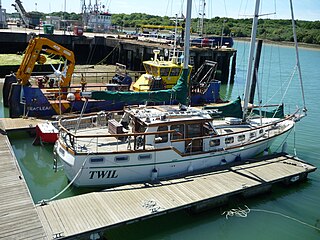The Catalina 38 is an American sailboat that was designed by Sparkman & Stephens as a racer-cruiser and first built in 1978.
The C&C Landfall 39 is a sailboat that was designed by C&C Design and Robert Perry and first built in 1985. The boat has a centre cockpit deck layout, which allows for an aft cabin interior.
The Island Packet 35 is an American sailboat that was designed by Robert K. Johnson as a cruiser and first built in 1988.
The Pilot 35 is an American sailboat that was designed by Sparkman & Stephens as a racer-cruiser and first built in 1962.
The S2 11.0 is a series of American sailboats that was designed by Arthur Edmunds as cruisers and first built in 1977. The designation indicates the approximate length overall in meters.
The Dickerson 37 is an American sailboat that was designed by George Hazen as a cruiser and first built in 1980.
The Sabre 38 is an American sailboat that was designed by Roger Hewson and the Sabre Design Team as a racer-cruiser and first built in 1981.
The Corbin 39 is a Canadian sailboat that was designed by Robert Dufour and Marius Corbin as a global circumnavigation cruiser and first built in 1979.
The Islander 40 is an American sailboat that was designed by Doug Peterson as a racer-cruiser and first built in 1979.
The Nordic 44 is an American sailboat that was designed by Robert Perry as a racer-cruiser and first built in 1980.
The Bristol 40 is an American sailboat that was designed by Ted Hood as a racer-cruiser and first built in 1970.
The Irwin 41 is an American sailboat that was designed by Ted Irwin as a cruiser and first built in 1982.
The Irwin 41 Citation is an American sailboat that was designed by Ted Irwin as a racer and first built in 1982. The design was bases on a custom boat designed by Irwin, named Razzle Dazzle, which won the Southern Ocean Racing Conference (SORC) in 1982.

The Tayana 37 is a Taiwanese sailboat that was designed by American Robert Perry as a cruiser and first built in 1976.

The Nauticat 44 is a Finnish motorsailer sailboat that was designed by Kaj Gustafsson as a cruiser and first built in 1974.
The Bristol Caravel 22, sometimes called the Bristol 22 Caravel, Sailstar Caravel, or just the Caravel 22, is an American trailerable sailboat that was designed by Halsey Chase Herreshoff as a cruiser and first built in 1968. It is named for the class of sailing ship.
The Fisher 25 or Fisher 25 MS is a British trailerable pilothouse sailboat that was designed by Wyatt and Freeman as a cruiser and first built in 1974.
The Freedom 21 is an American trailerable sailboat that was designed by Gary Hoyt and first built in 1982. It was available as a catboat or sloop rig.
The Mustang 22 is an American trailerable sailboat that was designed by Martin Bludworth as a Midget Ocean Racing Club racer and first built in 1969.
The Gulf 32 is an American sailboat that was designed by William Garden as a cruiser and first built in 1965.


